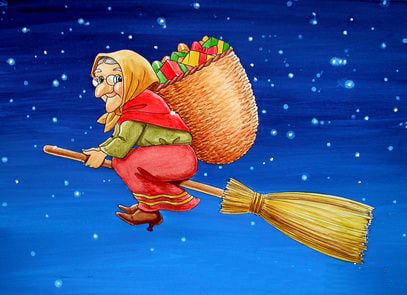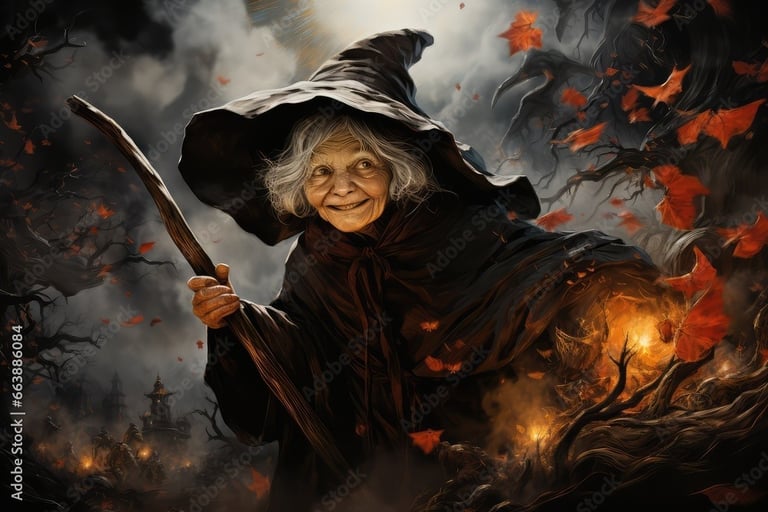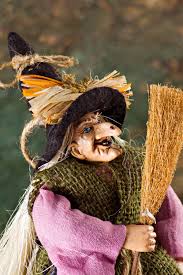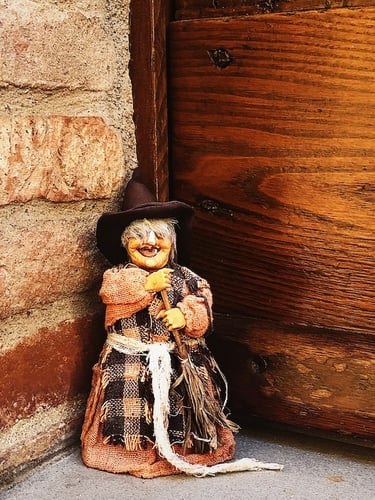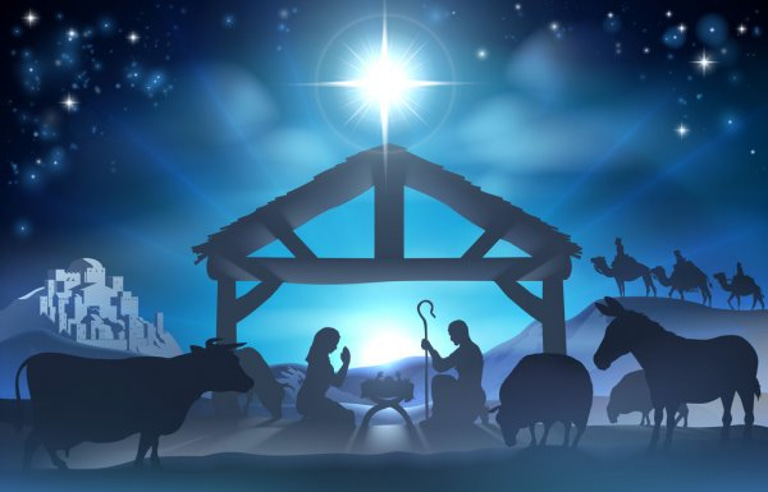Why Do Kids Love La Befana More Than the Wise Men?
Explore the charming tradition of La Befana. Find out how this beloved character makes Epiphany special for kids across Italy.
Grace Callahan
1/22/202517 min read
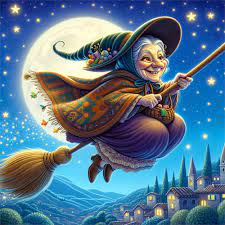

Introduction
In Italy, the arrival of Epiphany on January 6th brings the delightful tale of La Befana to life. This charming figure, often seen as a kind old woman on a broomstick, fills children's stockings with sweets, creating joy and excitement. But La Befana is more than just a festive character; her origins blend ancient folklore with modern customs. This post will explore the fascinating history, unique traditions, and the lasting appeal of La Befana in Italy, revealing why she remains a beloved part of the holiday season.
The Origins of La Befana
La Befana, a beloved figure in Italian folklore, has deep historical roots that weave together both pre-Christian and Christian traditions. Known as the Italian equivalent of Santa Claus, she embodies the spirit of gift-giving and festivity, especially during the Epiphany. But where did she come from? How did she evolve into the character we know today? Let’s explore the fascinating origins of La Befana.
Ancient Roman Roots and Ties to the Goddess Strenia
To truly understand La Befana, we must first look to ancient Roman traditions. During the Roman Republic, the month of January was dedicated to a goddess named Strenia. She was the goddess of health, fertility, and the New Year. Her name is derived from the word strena, meaning "good omen" or "lucky gift," and her festival, celebrated around the beginning of the year, was marked by the exchange of gifts.
The Strenia Connection: It is believed that Strenia’s festival involved the giving of presents—especially sweets and fruits—as symbols of good fortune for the coming year. These early gift-giving customs laid the foundation for the later tradition of La Befana. Some even argue that the gift-bearing character of La Befana could be a direct descendant of Strenia herself, blending pagan rites with later cultural shifts.
Fertility and Renewal: Strenia’s association with fertility and renewal might also resonate with the depiction of La Befana as a maternal figure who cleans and tidies homes, symbolizing a renewal of sorts for the New Year. It’s intriguing to think of La Befana as a carryover from this ancient celebration of life and growth.
For me, this connection to Strenia is both fascinating and beautiful. It's like La Befana carries the echoes of an ancient goddess, one who represented hope and renewal—a message that still resonates today.
Christian Adaptation of the La Befana Legend
As Christianity spread across Italy, many pagan traditions were adapted to fit the Christian narrative. La Befana’s legend is a perfect example of this blending. The story goes that the Three Wise Men (Magi) stopped at La Befana’s house on their way to see the baby Jesus. They invited her to join them, but she refused, too busy with housework. Later, she regretted her decision and set off to find them, bringing gifts for the baby Jesus. However, she never caught up to them, and so, in an act of penitence, she continued to give gifts to children every year in hopes that one day she might find the Christ child.
Symbolism of Redemption: This Christian adaptation of the legend carries a profound message about redemption and grace. La Befana’s story is one of missed opportunity, but also of second chances, as she continues her yearly search. It’s almost like a Christian parallel to the idea of seeking Jesus and giving to others as a form of penance.
Gift-Giving as a Christian Virtue: In Christian tradition, giving gifts is seen as an act of charity and love, reflecting the gifts given to Jesus by the Wise Men. La Befana, with her constant giving, aligns closely with this virtuous ideal.
I can’t help but think that the Christian adaptation adds an extra layer of depth to La Befana’s character—transforming her from a mere gift-bringer into a figure of faith, redemption, and eternal hope.
La Befana and the Epiphany Connection
La Befana’s most significant association is with the Epiphany, which is celebrated on January 6th. Epiphany marks the visit of the Wise Men to the infant Jesus, and in Italy, this day is as important as Christmas itself. La Befana, who is seen as bringing gifts to children on this day, has become the embodiment of Epiphany traditions.
The Night of January 5th: The night before Epiphany, La Befana is said to fly through the skies on her broomstick, delivering sweets and gifts to children who have been good, and leaving coal or ash for those who have misbehaved. This tradition mirrors that of Santa Claus, but with an Italian flair—La Befana is a solitary, elderly woman rather than a jolly old man.
A Journey of Discovery: In many ways, La Befana’s journey to find the Christ child mirrors the journey of the Magi. Just as the Wise Men followed the star to find Jesus, La Befana embarks on her own yearly pilgrimage to bring gifts to children, symbolizing the light of Christ illuminating the way. It’s a fascinating blend of myth and Christianity that adds layers of meaning to the celebration.
I think what makes La Befana so special is how seamlessly she fits into the fabric of Epiphany traditions, bringing with her a sense of warmth, joy, and community. Her presence reminds us that the season is not just about receiving gifts, but also about the spirit of giving and the journey toward spiritual fulfillment.
La Befana’s Role in Italian Epiphany Celebrations
La Befana is an integral part of the Epiphany celebration in Italy, a tradition that marks the arrival of the Three Wise Men to the newborn Jesus. Her story and the customs surrounding her visit are a unique and cherished part of Italian culture, blending the magic of folklore with deep religious meaning. But what is it about La Befana that makes her visit so special, and how does she fit into the larger narrative of Epiphany?
Her Journey to Visit the Baby Jesus
La Befana’s journey, much like that of the Magi, is rooted in the idea of pilgrimage. According to the legend, after the Wise Men passed through her home on their way to find the Christ child, they invited her to join them on their journey. She, however, declined, preoccupied with housework. Later, realizing her mistake, she tried to catch up with them but was never able to. Since then, she has made it her mission to deliver gifts to children on the night of January 5th, hoping to find the Christ child along the way.
The Journey’s Spiritual Significance: La Befana’s journey mirrors the spiritual quest for truth and enlightenment, symbolized by the Magi’s pursuit of the star leading to Jesus. Her continued search each year emphasizes the ongoing desire to seek goodness, redemption, and divine connection. It’s a beautiful metaphor for the Christian walk of faith—a journey that never truly ends, but rather continues through acts of kindness and grace.
I find it deeply moving how La Befana’s journey has transformed into something more than just a yearly gift-giving tradition. It’s as if, through her perpetual search, she is reminding us that the quest for spiritual fulfillment and the presence of Christ is something we must continue to pursue in our own lives.
The Symbolic Gifts: Coal for Naughty Children and Sweets for Good Ones
One of the most defining aspects of La Befana’s visit is the gift she leaves for children—sweets for those who have been good and coal or ash for those who have misbehaved. This tradition reflects both the joy of giving and the moral lessons embedded in the celebration of Epiphany.
Sweets for the Good: Just like the gifts of gold, frankincense, and myrrh given by the Wise Men, La Befana’s sweets symbolize reward and recognition for virtuous behavior. The sweet treats—candies, chocolates, or even small toys—serve as a reminder of the joy that comes with being kind and considerate. It’s a beautiful way to encourage good deeds while celebrating the light of Christ.
Coal for the Naughty: On the flip side, the coal is a playful, yet pointed reminder that good behavior is valued. It’s not meant to punish but to encourage self-reflection and growth. In many ways, the coal symbolizes the consequences of turning away from the light, while the sweets represent the sweetness of being in harmony with divine teachings.
I appreciate how La Befana’s gifts maintain a balance of both joy and discipline. There’s something rather poetic about the symbolism—sweets as a reward for the pursuit of goodness and coal as a gentle nudge toward improvement.
How La Befana’s Visit Parallels the Three Kings' Journey
La Befana’s visit to children on Epiphany night mirrors the journey of the Three Kings in fascinating ways. The Kings, guided by the star, journeyed to honor the newborn King of the Jews, bringing gifts as symbols of their respect and devotion. La Befana, in her own way, follows a similar path—though hers is a more personal one. She brings gifts to children, in hopes of honoring Christ and continuing her search for the divine.
The Pilgrimage of the Magi: The Wise Men’s journey is one of profound faith, following the star to find and worship Christ. In much the same way, La Befana’s journey represents the pursuit of that divine truth, even though she missed the moment of Christ’s birth. Every year, she renews her journey, symbolizing a never-ending search for spiritual enlightenment.
The Gift-Giving Tradition: Both the Magi and La Befana are givers of gifts—representing the values of generosity, love, and sacrifice. The gifts of the Magi, though regal and precious, symbolize reverence and the recognition of Christ’s significance. La Befana’s gifts, though more humble, symbolize a maternal, everyday love, with a focus on children and the hope that all will follow the light of Christ’s teachings.
To me, the parallel is striking. La Befana, though not part of the original Nativity story, has come to embody the spirit of the Magi’s journey, carrying the tradition of gift-giving and the pursuit of the divine into the hearts of families each year. Her visit brings together the wonder of the Epiphany with the warmth of maternal love and devotion.
Customs and Traditions Associated with La Befana
La Befana is a cherished part of Italian culture, and the customs and traditions associated with her are as varied and rich as the country itself. From her iconic broomstick to the way children eagerly await her arrival, La Befana brings a sense of wonder and excitement to the Epiphany celebration. But what are the deeper customs surrounding her, and why have they become such a beloved part of Italian tradition? Let’s explore the fascinating rituals that accompany this magical figure.
La Befana’s Broomstick and Flying Through the Night
One of the most enchanting aspects of La Befana is her ability to travel through the night sky on a broomstick, delivering gifts to children across Italy. This image of La Befana flying from home to home has captured the imaginations of both children and adults for generations.
The Symbolism of the Broomstick: The broomstick itself is not just a means of transportation; it’s also symbolic. In folklore, broomsticks are often associated with witches, who are seen as women with magical powers. La Befana, though, is not a witch in the traditional sense. Instead, she represents the maternal figure—caring and wise, bringing both joy and moral lessons to children. The broomstick also hints at her humble, everyday nature, grounding her as a down-to-earth character who, despite her magical abilities, is rooted in kindness and love.
The Night Journey: La Befana’s flight through the night also symbolizes the journey of faith. Just as the Magi followed the star to reach the Christ child, La Befana flies through the night, guided by her own sense of devotion. For me, this idea of traveling through the night captures the essence of hope, perseverance, and the belief that the divine is always watching over us, even in the darkest of times.
I’ve always found the image of La Befana on her broomstick to be both whimsical and deeply symbolic. It’s as if she’s a figure who straddles the magical and the spiritual, using her powers to spread goodness while reminding us of the importance of seeking the light.
The Folklore of Children Leaving Stockings or Shoes for Her Gifts
Just as Santa Claus has his own ritual—leaving him milk and cookies—La Befana has her own special custom: children leave out stockings or shoes for her to fill with gifts. The tradition of placing shoes or stockings by the fireplace, or near the door, is a magical moment that children eagerly anticipate, hoping for sweets and small treats in the morning.
Stockings and Shoes as Symbols of Hospitality: Leaving a gift for La Befana is a way for children to show hospitality and good behavior. The shoes or stockings become a symbol of receptivity—open to the gifts of kindness and wisdom that La Befana brings. Some regions even encourage children to leave a note for her, sometimes asking for a specific gift, much like the way children write letters to Santa.
The Coal for Naughty Children: Of course, not all children receive sweet treats. If a child has been naughty, they might find a lump of coal or a piece of ash in their stocking or shoe. It’s a playful, yet moral reminder that actions have consequences, and that goodness should be rewarded. It’s always fascinating how this small, seemingly mischievous detail maintains the balance between fun and lessons in behavior.
For me, there’s something so touching about the simple act of leaving out shoes. It’s as if the act itself is an invitation for La Befana to enter your home and bring not just gifts, but a piece of the holiday magic.
Regional Variations of La Befana Celebrations Across Italy
As with most Italian traditions, La Befana’s celebrations vary from region to region, adding even more depth and charm to her legend. Every region puts its own spin on the story, with different customs and events that reflect local culture and history.
In Rome: The capital is especially devoted to La Befana, with events and festivals held across the city. A highlight is the large Epiphany parade that winds through the streets, with La Befana making her grand appearance at the end. For many Romans, La Befana’s arrival marks the final day of the Christmas festivities, with grand celebrations that tie together both the religious and folk aspects of the holiday.
In Sicily: In southern Italy, La Befana is often portrayed in a more festive light, with elaborate processions and parties that celebrate the arrival of the Epiphany. Sicilian children are especially excited about the day, as it is a time to not only receive gifts but to join in on public festivities with music, dancing, and street markets.
In the North: In regions like Milan and Piedmont, the traditions surrounding La Befana can be more solemn, with religious ceremonies held in churches, reflecting the deeper spiritual significance of the day. However, even in these areas, children still eagerly await her visit, and the streets often come alive with parades and public performances.
What strikes me is how these regional differences highlight the diversity within Italian culture. Despite variations in the way La Befana is celebrated, one thing remains constant: the love and reverence Italians have for this magical figure. Whether it’s through grand parades, intimate family rituals, or religious services, La Befana unites Italians in a shared moment of joy and reflection.
The La Befana Parade and Festivals
La Befana’s arrival on the night of January 5th is celebrated across Italy with vibrant festivals, parades, and events that bring her legendary journey to life. These celebrations have become integral parts of Italian culture, highlighting the joy, tradition, and community spirit that characterize the Epiphany season. But how did these festivals become so widespread, and what makes them so special? Let’s take a closer look at the major La Befana celebrations across Italy, with a focus on the spectacular events that take place in cities like Rome, Milan, and Urbania.
Major Festivals Celebrating La Befana Across Italy
La Befana’s festivals are a mix of religious reverence, local folklore, and pure fun, drawing crowds from all over the world. Across Italy, these celebrations range from quiet, family-oriented customs to grand public spectacles. Each festival reflects the distinct character of the region it’s held in, yet all share a common theme: the arrival of La Befana to deliver gifts, spread joy, and celebrate the Epiphany.
The Festival of La Befana in Rome: As the capital of Italy, Rome holds one of the most exciting and widespread La Befana celebrations. Parades fill the streets, and the city’s piazzas come alive with performances, games, and music. The most significant event is the Festa della Befana, where La Befana is celebrated with a special procession in the heart of the city. Children eagerly gather in the piazzas to receive gifts from La Befana, and the streets are lined with markets selling festive treats, sweets, and crafts. Rome’s La Befana celebrations are a mixture of religious reflection and carnival-like fun, showcasing the city’s blend of history and joy.
La Befana in Milan: Milan, with its more cosmopolitan vibe, adds a unique flair to the La Befana celebrations. The city's streets and squares host grand parades, while families and children dress up as La Befana to join in the fun. Milan’s festivals often include cultural performances, folk music, and storytelling that center around the beloved witch-like figure. The festivities blend tradition with modernity, creating an atmosphere that’s both lively and reflective. Milan is where the younger generation takes the lead, transforming La Befana into a celebration of community, culture, and joy.
The Town of Urbania and the Largest La Befana Celebration
While cities like Rome and Milan shine with their grand La Befana celebrations, there’s one small town in central Italy that holds the title of the largest and most spectacular La Befana festival: Urbania. Nestled in the Marche region, Urbania is often referred to as the “capital” of La Befana, and for good reason.
The History and Magnitude of the Urbania Festival: Urbania’s La Befana celebration dates back decades and has grown into a month-long event that attracts thousands of visitors. The highlight of the festival is the grand La Befana parade, where La Befana figures from all over Italy gather to participate. The town’s streets are transformed into a wonderland of lights, decorations, and festive stalls, creating a magical atmosphere for families and tourists alike.
The Iconic La Befana Parade: Urbania’s parade is the star of the show. La Befana figures of all shapes and sizes take part, many of them riding on broomsticks or wearing the traditional ragged dresses and headscarves. This colorful parade winds through the town, drawing cheers from the crowd. The event is a visual feast of costumes, floats, and traditional music. It’s a true celebration of community, history, and Italian tradition.
The Town's Year-Round Focus on La Befana: Urbania also dedicates much of the year to La Befana, hosting exhibitions, workshops, and storytelling sessions about the legend. For those interested in learning more about La Befana’s origins, Urbania’s museum offers a deep dive into her history and cultural significance.
Parades, Costumes, and Public Festivities in Cities Like Rome and Milan
La Befana’s parades and festivals are not just about her journey—they’re about community and collective celebration. In both Rome and Milan, the events are immersive, involving the participation of people from all walks of life.
Costumes and Public Participation: One of the most joyous aspects of these celebrations is the opportunity for everyone to get involved. Children (and adults) often dress up as La Befana, donning the traditional broomstick and tattered clothing, while others choose to wear costumes of the Wise Men, angels, or other characters from the Nativity story. It’s a time for people to come together and celebrate the Epiphany in a festive, participatory way. The costumes add a sense of whimsy to the celebrations, allowing people to step into the folklore of the day.
The Festivities in Rome: In Rome, the festivities are characterized by their sheer scale. Beyond the parade, there are street performances, live music, and pop-up stalls selling festive foods and candies. Public squares like Piazza Navona are taken over by families, with games, puppet shows, and even special events for children to meet La Befana. The atmosphere is one of warmth, excitement, and celebration—there’s no better place to experience the joy of the Epiphany.
The Milan Experience: Milan, though known for its style and modernity, knows how to throw a La Befana celebration full of charm. The parades in Milan are a mix of historical reenactments and modern performances, with the city’s residents dressed in traditional costumes while others engage in fun, interactive activities. The local shops join in with special Epiphany sales, making it a festive atmosphere from street to street.
La Befana’s Influence on Italian Culture and Beyond
La Befana, with her broomstick and bag of treats, has become an enduring symbol in Italian culture, influencing everything from art and literature to modern films and commercial ventures. But how far does her influence really stretch? And how does this beloved figure resonate with Italian diaspora communities around the world? Let’s dive into La Befana’s cultural impact, both in Italy and beyond, and explore how she’s been reinterpreted and commercialized in the modern age.
La Befana in Italian Art, Literature, and Films
It’s impossible to talk about La Befana without recognizing the profound impact she’s had on Italian art, literature, and cinema. This beloved figure has been depicted in a wide array of artistic forms, ranging from traditional paintings to contemporary films, and each interpretation adds layers to her already rich folklore.
Artistic Depictions: Historically, La Befana has been represented in many Italian artworks, especially during the Renaissance and Baroque periods. Artists often portrayed her as a wise and maternal figure, sometimes in scenes that depicted her with the Magi or delivering gifts to children. Her image has evolved over time, blending the witch-like figure of early folklore with the nurturing qualities of a grandmotherly woman.
Literature and Folklore: La Befana’s story has been immortalized in Italian literature, from fairy tales to contemporary short stories. Writers have taken her character and shaped it into stories that emphasize themes of kindness, redemption, and love. Her journey—her willingness to turn back and seek the Christ child after initially refusing—has also been interpreted as a metaphor for personal growth, redemption, and the triumph of good over evil.
Films and Television: In the 20th and 21st centuries, La Befana has been a character in numerous Italian films and television shows, where her role has been both comedic and serious, magical and down-to-earth. Films like La Freccia Azzurra (The Blue Arrow), a popular Italian animated film, have made La Befana an even more accessible and enchanting figure for younger audiences. Her character has also been reinterpreted in modern holiday specials, continuing to capture the imagination of audiences both in Italy and internationally.
How the La Befana Tradition is Celebrated in Italian Diaspora Communities
La Befana’s magic has not remained confined to Italy. As Italians emigrated to other parts of the world, they brought their customs and traditions with them, including the beloved Befana celebrations. While the way La Befana is celebrated varies by location, the essence of the tradition—family, community, and joy—remains the same.
In the United States: In areas with large Italian-American populations, like New York and New Jersey, La Befana is celebrated with parades, festivals, and local events, often in conjunction with Epiphany celebrations. Italian-American families maintain the tradition of leaving stockings for La Befana, passing down stories of her nightly journey to bring gifts and coal.
In South America: Countries like Argentina, Brazil, and Uruguay also celebrate La Befana, especially in communities with strong Italian roots. These countries incorporate their own cultural elements into the tradition, blending La Befana with local customs and practices. In Brazil, for example, there’s a special “Befana parade” in São Paulo, with a festive atmosphere and activities that honor both the Italian heritage and the Brazilian love for celebration.
In Australia and Canada: Italian communities in Australia and Canada have also kept the tradition alive, hosting events that feature traditional La Befana rituals, complete with parades, food, and music. The celebrations often emphasize community spirit and family togetherness, just as they do in Italy.
For me, it’s heartwarming to see how La Befana has traveled the world and been embraced by Italian communities everywhere. No matter the location, her story continues to foster a sense of connection to heritage, reminding people of the importance of family, kindness, and celebrating the Epiphany season.
Modern Interpretations and Commercialization of La Befana
In today’s world, La Befana has been subject to both reinterpretations and commercialization, but this isn’t necessarily a bad thing. While some may argue that her essence has been watered down in the process, I believe these modern twists reflect how deeply ingrained she’s become in global holiday traditions.
Modern Interpretations: Today, La Befana is often portrayed in ways that resonate with contemporary sensibilities. Her image has been updated for advertising campaigns, children’s books, and online content, sometimes as a more relatable figure who embodies generosity and care. Many modern-day renditions emphasize her role as a strong, independent woman who plays a pivotal role in the Epiphany story. These updates help make her relevant in an increasingly secular world.
Commercialization: Just like Santa Claus, La Befana has found her way into the commercial realm. Her likeness is featured on everything from holiday ornaments to greeting cards and merchandise. In Italy, stores line their shelves with Befana-themed products: from dolls to chocolate, to the ubiquitous coal-shaped candies. While some may view this as a commercialization of a deeply spiritual tradition, others see it as a natural evolution of how cultural symbols adapt to modern life. For me, it’s interesting how La Befana has become a figure who is simultaneously tied to both religious and secular holiday celebrations. It’s almost as if the celebration of the Epiphany has evolved into a global festive event, with La Befana at the heart of it.
Conclusion
La Befana is not just a character in Italian folklore; she embodies the spirit of generosity and joy during the festive season. As she combines ancient traditions with Christian stories, La Befana continues to delight millions every Epiphany. Her unique customs and vibrant celebrations highlight the warmth of Italian culture. Discover the magic of La Befana and join in the festivities that celebrate this beloved figure. Embrace the spirit of giving and joy that she represents.
